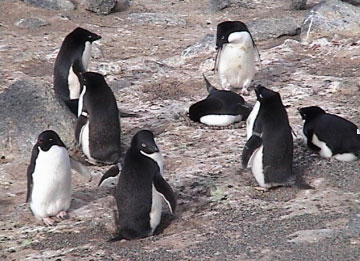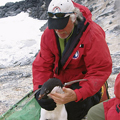Adventures with Adélie Penguins at Cape Royds in the 2007–08 Austral Summer

We have set out in the 12th year of a project in which we seek to understand why Adélie Penguin populations have been increasing in the Ross Sea since the early 1980s, and why the increase has mostly been exhibited by smaller colonies. Although only about 13% of the Antarctic continental circumference, the Ross Sea contains about 38% of the 6 million breeding Adélie Penguins in the world, and 3 of its largest colonies (3 of 6 exceeding 120,000 breeding pairs). We know about this population increase from the frequent and, in some cases, annual counts being made of the colonies by biologists of Landcare Research New Zealand, using aerial photography. The reason it is taking us so long in this quest is that we need to accumulate the individual histories of known-age birds, acquiring information for each bird, such as year of hatching, year of first breeding, and subsequent breeding success. We also need to know the proportion of each age group that survives from one year to the next, and whether or not as young adults they return to the colony of their origin or move elsewhere (emigrate) to nest at another colony.

Important to this quest is the banding of chicks (with a metal band that has a unique set of numbers) at 4 colonies every year: Cape Crozier (150,000 pairs), Beaufort Island (45,000 pairs), Cape Bird (40,000 pairs), and Cape Royds (4000 pairs). Otherwise, we spend a lot of time walking, with binoculars in hand, looking for penguins wearing bands at those 4 colonies. They don’t first come back for a visit until they’re 2 years old, and they don’t begin to breed until, on average, 4 or 5 years of age. The penguins reveal their secrets slowly, and so we must be patient. We are pleased that folks at the National Science Foundation, which funds our project, are patient, too. In any case, we began this 12th year, leaving the USA on 4 Nov, arriving in Christchurch NZ on 6 Nov and then, after a few days of weather delay, arriving at McMurdo Station, Ross Island, on 11 Nov. While in McMurdo we attended courses on survival in extreme conditions, proper conduct in specially protected areas, and the proper disposal/recycling of no-longer-needed materials (cans, bottles, paper, metal, etc.). McMurdo saves for recycling about 80% of its refuse (the remainder goes in a landfill in the USA). During this period, too, we sorted through our field gear and acquired our camping gear from the Berg Field Center. We had to do this for 3 camps, all on Ross Island: Cape Crozier (a hut there), Cape Bird (a hut), and Cape Royds (a tent). We had at least a ton of stuff, including food.

 No comments
No comments 






